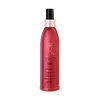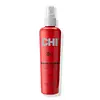What's inside
What's inside
 Key Ingredients
Key Ingredients

 Benefits
Benefits

 Concerns
Concerns

 Ingredients Side-by-side
Ingredients Side-by-side

Water
Skin ConditioningVp/Va Copolymer
Isoceteth-20
EmulsifyingLinum Usitatissimum Seed Extract
PerfumingPhyllostachys Bambusoides Extract
Skin ConditioningHydrolyzed Rice Protein
Skin ConditioningTuber Magnatum Extract
Skin ConditioningPearl Extract
AntioxidantHydrolyzed Silk
HumectantPanthenol
Skin ConditioningPolyquaternium-11
Caprylyl Glycol
EmollientPPG-20 Methyl Glucose Ether
Skin ConditioningCetrimonium Chloride
AntimicrobialGlycerin
HumectantHexylene Glycol
EmulsifyingCitric Acid
BufferingSodium Bisulfite
AntioxidantLaurtrimonium Chloride
EmulsifyingPhenoxyethanol
PreservativePotassium Sorbate
PreservativeBenzyl Alcohol
PerfumingEthylhexylglycerin
Skin ConditioningSodium Benzoate
MaskingParfum
MaskingBenzyl Benzoate
AntimicrobialCitral
PerfumingCoumarin
PerfumingLimonene
PerfumingLinalool
PerfumingWater, Vp/Va Copolymer, Isoceteth-20, Linum Usitatissimum Seed Extract, Phyllostachys Bambusoides Extract, Hydrolyzed Rice Protein, Tuber Magnatum Extract, Pearl Extract, Hydrolyzed Silk, Panthenol, Polyquaternium-11, Caprylyl Glycol, PPG-20 Methyl Glucose Ether, Cetrimonium Chloride, Glycerin, Hexylene Glycol, Citric Acid, Sodium Bisulfite, Laurtrimonium Chloride, Phenoxyethanol, Potassium Sorbate, Benzyl Alcohol, Ethylhexylglycerin, Sodium Benzoate, Parfum, Benzyl Benzoate, Citral, Coumarin, Limonene, Linalool
Water
Skin ConditioningVp/Va Copolymer
Cocodimonium Hydroxypropyl Silk Amino Acids
Skin ConditioningPanthenol
Skin ConditioningPolysorbate 20
EmulsifyingPolyquaternium-16
Caprylyl Glycol
EmollientPhenoxyethanol
PreservativePPG-20 Methyl Glucose Ether
Skin ConditioningOlealkonium Chloride
Potassium Sorbate
PreservativeHexylene Glycol
EmulsifyingCitric Acid
BufferingAlumina
AbrasiveSilica
AbrasiveCI 77891
Cosmetic ColorantParfum
MaskingBenzyl Benzoate
AntimicrobialButylphenyl Methylpropional
PerfumingCitronellol
PerfumingWater, Vp/Va Copolymer, Cocodimonium Hydroxypropyl Silk Amino Acids, Panthenol, Polysorbate 20, Polyquaternium-16, Caprylyl Glycol, Phenoxyethanol, PPG-20 Methyl Glucose Ether, Olealkonium Chloride, Potassium Sorbate, Hexylene Glycol, Citric Acid, Alumina, Silica, CI 77891, Parfum, Benzyl Benzoate, Butylphenyl Methylpropional, Citronellol
Ingredients Explained
These ingredients are found in both products.
Ingredients higher up in an ingredient list are typically present in a larger amount.
Benzyl Benzoate is usually created from the condensation of benzoic acid and benzyl alcohol. It is used as a preservative, solvent, and has a floral/balsamic scent in large amounts.
As a preservative, Benzyl Benzoate works against bacteria and fungus. It is often used to treat scabies and lice in medicine.
Solvents are used to keep ingredients together in a product. They can help dissolve ingredients to stable bases or help evenly distribute ingredients throughout the product.
Due to its fragrance, Benzyl Benzoate can be sensitizing and may cause contact dermatitis. It is a known EU allergen. We recommend speaking with a professional if you have any concerns.
Benzyl Benzoate can be naturally found in cranberries and peaches.
Learn more about Benzyl BenzoateCaprylyl Glycol is a humectant and emollient, meaning it attracts and preserves moisture.
It is a common ingredient in many products, especially those designed to hydrate skin. The primary benefits are retaining moisture, skin softening, and promoting a healthy skin barrier.
Though Caprylyl Glycol is an alcohol derived from fatty acids, it is not the kind that can dry out skin.
This ingredient is also used as a preservative to extend the life of products. It has slight antimicrobial properties.
Learn more about Caprylyl GlycolCitric Acid is an alpha hydroxy acid (AHA) naturally found in citrus fruits like oranges, lemons, and limes.
Like other AHAs, citric acid can exfoliate skin by breaking down the bonds that hold dead skin cells together. This helps reveal smoother and brighter skin underneath.
However, this exfoliating effect only happens at high concentrations (20%) which can be hard to find in cosmetic products.
Due to this, citric acid is usually included in small amounts as a pH adjuster. This helps keep products slightly more acidic and compatible with skin's natural pH.
In skincare formulas, citric acid can:
While it can provide some skin benefits, research shows lactic acid and glycolic acid are generally more effective and less irritating exfoliants.
Most citric acid used in skincare today is made by fermenting sugars (usually from molasses). This synthetic version is identical to the natural citrus form but easier to stabilize and use in formulations.
Read more about some other popular AHA's here:
Learn more about Citric AcidHexylene Glycol is a surfactant. Glycols are a class of alcohols. Hexylene Glycol is a surfactant and emulsifier.
As a surfactant, Hexylene Glycol helps gather dirt and oil on your skin to be washed away.
As an emulsifier, Hexylene Glycol helps keep water and oil together. This prevents them from separating in a product. Hexylene Glycol also thins out the texture of a product by lessening viscosity.
Hexylene Glycol has a small molecular weight.
Learn more about Hexylene GlycolPanthenol is a common ingredient that helps hydrate and soothe the skin. It is found naturally in our skin and hair.
There are two forms of panthenol: D and L.
D-panthenol is also known as dexpanthenol. Most cosmetics use dexpanthenol or a mixture of D and L-panthenol.
Panthenol is famous due to its ability to go deeper into the skin's layers. Using this ingredient has numerous pros (and no cons):
Like hyaluronic acid, panthenol is a humectant. Humectants are able to bind and hold large amounts of water to keep skin hydrated.
This ingredient works well for wound healing. It works by increasing tissue in the wound and helps close open wounds.
Once oxidized, panthenol converts to pantothenic acid. Panthothenic acid is found in all living cells.
This ingredient is also referred to as pro-vitamin B5.
Learn more about PanthenolParfum is a catch-all term for an ingredient or more that is used to give a scent to products.
Also called "fragrance", this ingredient can be a blend of hundreds of chemicals or plant oils. This means every product with "fragrance" or "parfum" in the ingredients list is a different mixture.
For instance, Habanolide is a proprietary trade name for a specific aroma chemical. When used as a fragrance ingredient in cosmetics, most aroma chemicals fall under the broad labeling category of “FRAGRANCE” or “PARFUM” according to EU and US regulations.
The term 'parfum' or 'fragrance' is not regulated in many countries. In many cases, it is up to the brand to define this term.
For instance, many brands choose to label themselves as "fragrance-free" because they are not using synthetic fragrances. However, their products may still contain ingredients such as essential oils that are considered a fragrance by INCI standards.
One example is Calendula flower extract. Calendula is an essential oil that still imparts a scent or 'fragrance'.
Depending on the blend, the ingredients in the mixture can cause allergies and sensitivities on the skin. Some ingredients that are known EU allergens include linalool and citronellol.
Parfum can also be used to mask or cover an unpleasant scent.
The bottom line is: not all fragrances/parfum/ingredients are created equally. If you are worried about fragrances, we recommend taking a closer look at an ingredient. And of course, we always recommend speaking with a professional.
Learn more about ParfumPhenoxyethanol is a preservative that has germicide, antimicrobial, and aromatic properties. Studies show that phenoxyethanol can prevent microbial growth. By itself, it has a scent that is similar to that of a rose.
It's often used in formulations along with Caprylyl Glycol to preserve the shelf life of products.
Potassium Sorbate is a preservative used to prevent yeast and mold in products. It is commonly found in both cosmetic and food products.
This ingredient comes from potassium salt derived from sorbic acid. Sorbic acid is a natural antibiotic and effective against fungus.
Both potassium sorbate and sorbic acid can be found in baked goods, cheeses, dried meats, dried fruit, ice cream, pickles, wine, yogurt, and more.
You'll often find this ingredient used with other preservatives.
Learn more about Potassium SorbateWe don't have a description for PPG-20 Methyl Glucose Ether yet.
We don't have a description for Vp/Va Copolymer yet.
Water. It's the most common cosmetic ingredient of all. You'll usually see it at the top of ingredient lists, meaning that it makes up the largest part of the product.
So why is it so popular? Water most often acts as a solvent - this means that it helps dissolve other ingredients into the formulation.
You'll also recognize water as that liquid we all need to stay alive. If you see this, drink a glass of water. Stay hydrated!
Learn more about Water